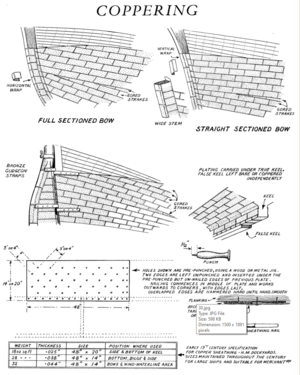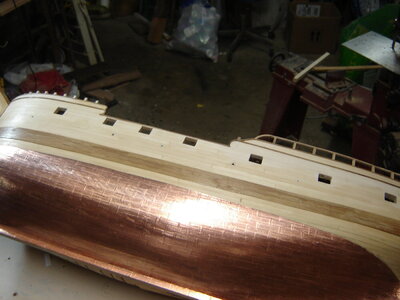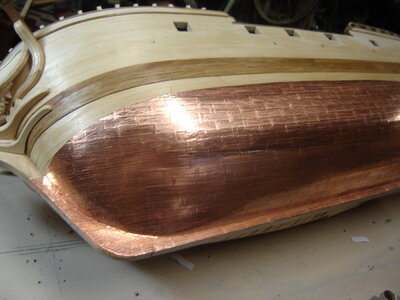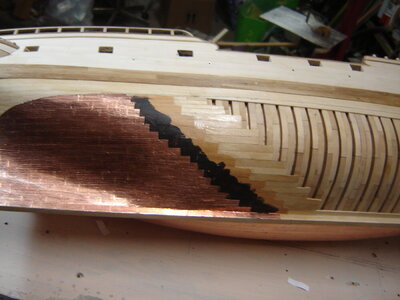- Joined
- Oct 17, 2020
- Messages
- 1,687
- Points
- 488

Hello, I post a short article about copper plating news. FrankQuite true, except for some copper alloys. I’m kind of assuming they weren’t using pure copper, which could be completely wrong. If it was pure, you can easily work harden copper cold, it’s one of the reasons I always hated working with it. Twisting copper wire will make it hard.
Having said all that, I’m not confident hardened wire copper nails would have been strong enough to go into oak or teak. Maybe they used a bradawl or punch to create the hole and used the copper nail more like a rivet.
An Account of Lead Sheathing, Formerly used for the Protection of Ships' Bottoms.
Extracted from a work published in 1695.
[p 73]The following are added as curious documents, and which no doubt will be considered as such by Naval Officers, who may never have seen or heard of the book from which they are copied. By this book it appears, that at the time specified a new mode of Milling Sheet Lead was invented, it was tried first upon a few ships only, and found to possess so many advantages over the old wooden, weed, barnacle, muscle, and other rubbish-creating impediments to a ship's sailing, that "twenty of His Majesty's* ships were ordered to be sheathed with the said milled lead" — that the King, Privy Council, Admiralty, and Parliament, all were delighted with this new invention — The King that "it would save him Forty Thousand Pounds a year in his Navy; the which was not improbable if it had met with that due encouragement, with regard had to the charge and damage that wooden sheathing brings to the plank by the great nail-holes, which the use to spile up at stripping."
It however happened, as stated in my little book, "that a great and wonderful discovery was made;" that the lead, which as farther stated by the "Mill'd-Lead Company," had been time immemorial "used as a defense to all iron in ships' bottoms, had corroded the rudder-irons in a shorter time than ever had been known with the wooden sheathing, or without any sheathing whatever."
It was pretty roundly stated also, by the Milled-Lead Company, that those who supplied the Navy Board with the "wood sheathing, hair, tallow, oil, brimstone, rosin," and twenty other et ceteras, had found out that the secret of making the Commissioners, Surveyors and others, believe, that compared to the above compound, Lead-sheathing was little better than sarsnet**.
By the said book it appears, that after a long contention between the Patent Milled-Lead Sheathing Company and the Navy Board, the Milled Lead sheathing was abandoned, and the wooden sheathing was re-adopted, until that of copper was introduced, being about a century. What may have been the result to the Navy, and the Nation, is not easy to say — that the loss must have amounted to hundred of ships*** — thousands of lives — and millions of money, cannot be doubted — for it had been sufficiently proved, that the lead was a complete defence against the worm; that it was less liable foul, and more easily cleansed; that instead of requiring to be shifted every three years, it would last seven or more — and to sum up all, that the ship with a lead sheathing was a more efficient man-o'-war, by perhaps twenty per cent, than with a wooden sheathing.
In another part of this little book, the following appears — "Nor could those of the Navy Board, when at their attendance on the Council with their complaints of eight ships in twenty, make the least objection (though they were fairly challenged to it) against the Rudder-Irons, Bolts, or other iron work of the Phœnix; the which made that judicious Peer the then Earl of Hallifax declare, That if of twenty ships, they complained of nineteen, and had nothing to say against the twentieth, he must conclude it to be the workmens' fault; for if they had done the other nineteen as that twentieth ship was done, they must have proved all as well she."
*







